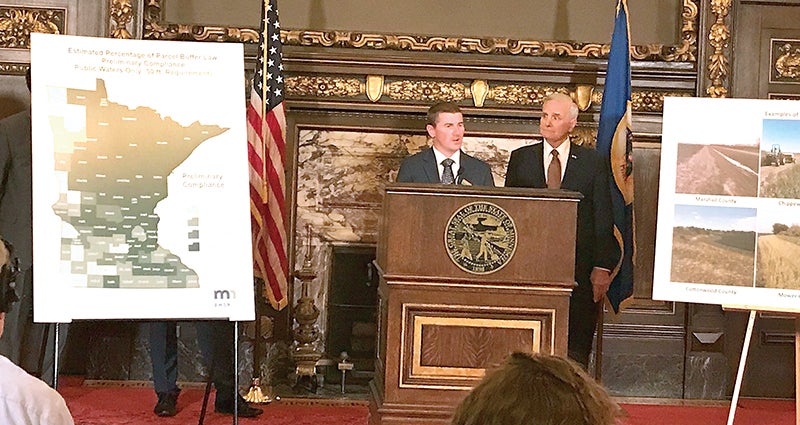Governor thanks farmers for buffers; Director of local SWCD on hand to offer comments
Published 9:31 am Tuesday, October 31, 2017

- Mower County Soil and Water Conservation District Manager Justin Hanson stands with Minnesota Gov. Mark Dayton during a news conference about compliance with the new buffer law on Monday in St. Paul. The governor reported that 95 percent of the state’s parcels are in compliance with the first phase of the new law. Photo courtesy of Minnesota Board of Water & Soil Resources
Over 86 percent of Mower County’s parcels are compliant with the state’s new water quality buffer law, that requires the landowner to install perennial vegetation between crops and public waterways and ditches.
Farmers needing waivers from the Nov. 1 deadline need to contact the Mower County Soil and Water Conservation District by tomorrow, according to the new law. If they commit to a compliance plan to implement a buffer, or an alternative plan, a waiver until July. 1, 2018, would be granted. There are two types of waivers; one that shows hardship in meeting the deadline due to harvest; or a waiver that shows need for technical or financial assistance.
The law says a 50-foot buffer will be needed along public waterways — such as lakes, streams and rivers — and 16 and a half foot buffer along public ditches.
Gov. Mark Dayton on Monday said 95 percent of the state’s parcels are already in compliance with the law, and was the subject of two press conferences in St. Paul.
One press conference was held to thank farmers and soil and water districts for their work that resulted in “a remarkable amount of progress,” Dayton later said — and the second allowed media to ask questions following presentations by Dayton, Minnesota Board of Water and Soil Resources Executive Director John Jaschke, Mower County Soil and Water Conservation District Manager Justin Hanson, and Deputy Commissioner of the Minnesota Department of Agriculture Matt Wohlman.
In the first phase of providing buffers along public waterways and ditches, 95 percent of the state’s parcels were in compliance, Dayton said on Monday.
“It’s really been extraordinary,” Dayton said. “It’s a very customized program that meets individualized needs.”
Hanson agreed, adding the program’s flexibility allows landowners to “have lots of opportunity to have ownership of the decisions made for your land … let’s get those waivers done.” It was estimated that 1,800 state parcels had yet to come into compliance under the law.
According to Mower County Soil and Water District, out of the 404 letters sent by the district to landowners with potential compliance issues, action plans have been designed for 361 of that number.
Mower SWCD Water Plan and Outreach Coordinator Tim Ruzek clarified Mower’s compliance numbers have to date been reported in acreage instead of the state’s practice of using parcels. Out of 4,892 acres, 96.5 percent of the county’s acreage is in compliance. Total parcels affected in Mower County by the buffer law/shoreland impact zone are 2,352 parcels, he said. Out of those, only 42 parcels have yet to contact Mower SWCD regarding their compliance issue, he noted.
No matter what the measure, the high compliance rate comes from hard work and far-sighted landowners, many of who have had buffer strips in place for a long time, Jaschke said.
“Buffer practices “are proven, tried and true” and research has shown those practices to improve water quality, he added. Not only do the buffers work to treat water, by filtering out chemicals, they also work to hold banks from erosion.
“These are fundamental things,” Jaschke said.



